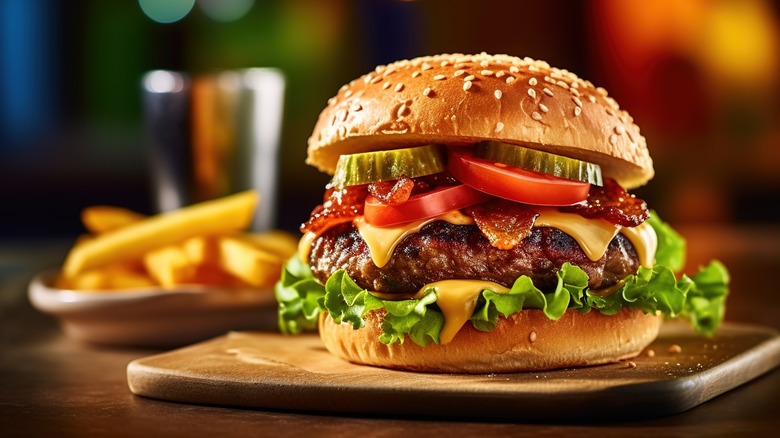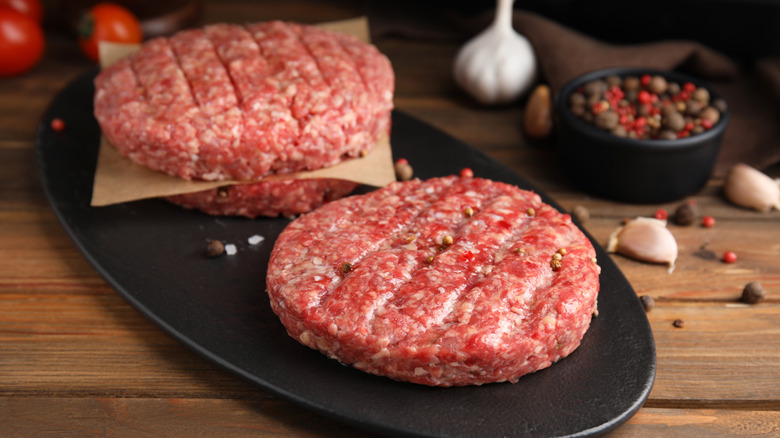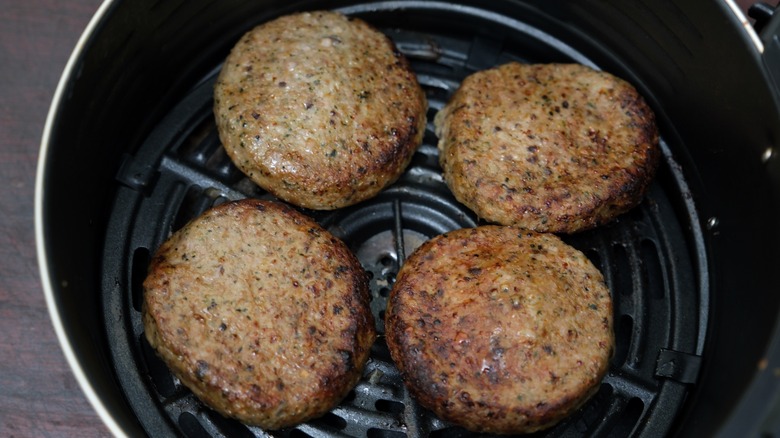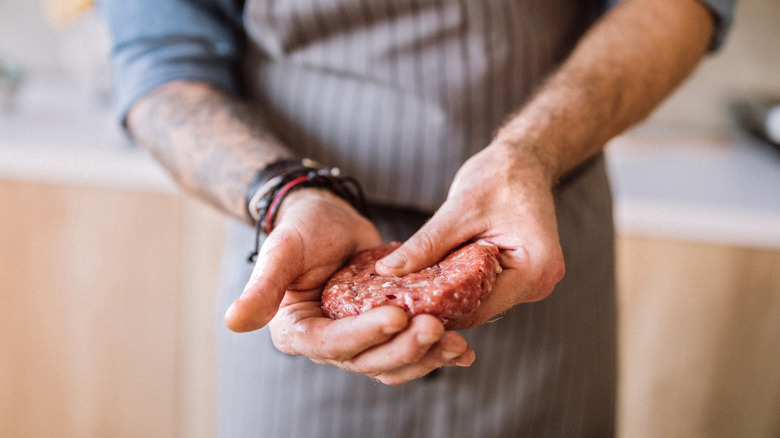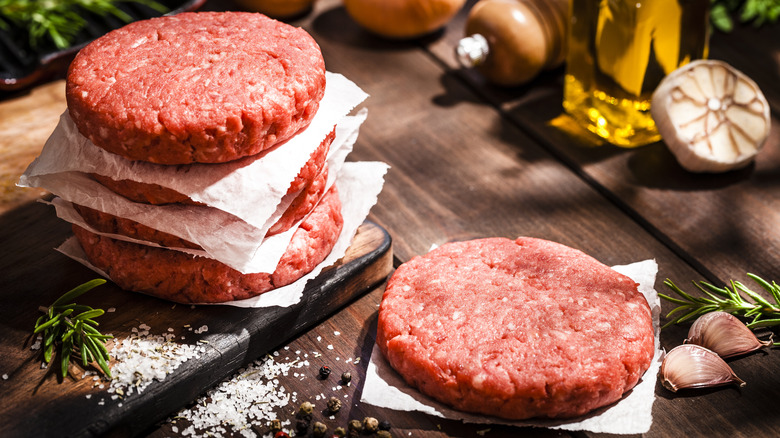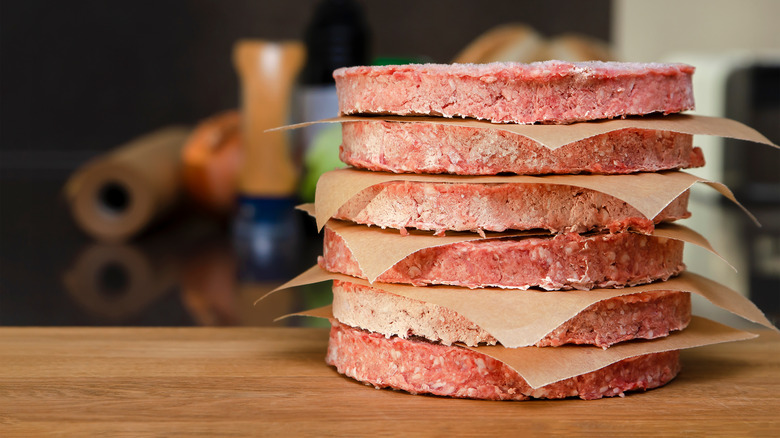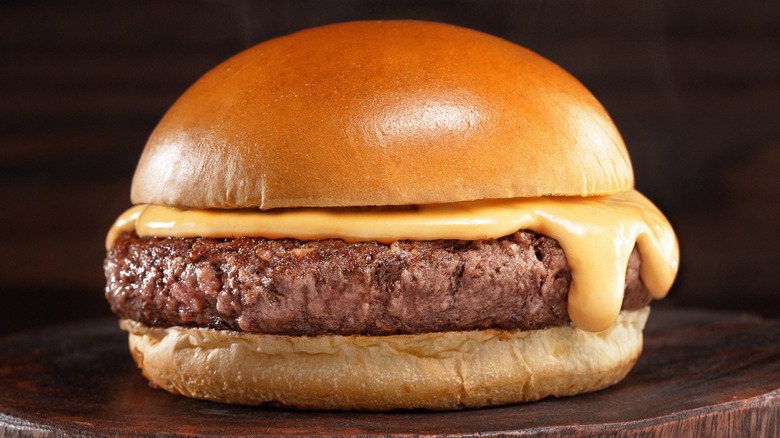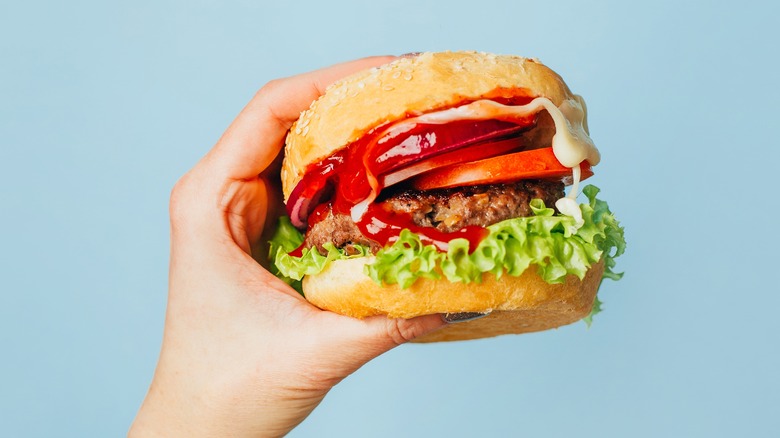How To Prep Fresh Vs Frozen Hamburgers For The Air Fryer
Nothing beats the delectable flavors in a good hamburger, a combination of a juicy patty, a pillowy bun, and toppings like melty cheese, a crunchy piece of lettuce, or even a runny egg. But not everyone has the time to crank up a stovetop or an outdoor grill to cook the patties, or we may not have the know-how to form beef patties from scratch. Whether you're in a rush or dealing with unsavory weather conditions, an air fryer can easily whip up a batch of hamburgers in no time.
This handy appliance can cook burgers made from scratch as well as frozen, readymade options from your local grocery store. However, there are a few preparation tips you must follow in order to get your air fryer to churn out perfectly cooked burgers every time. Nailing the preparation of both fresh and frozen hamburgers requires you to follow slightly different tips on preparation, the right settings on your air fryer, and cooking time. Here are some suggestions to follow if you want to cook either type of beef patty just right.
Fresh versus frozen patties
While many burger enthusiasts swear that only patties made with fresh ground beef are worth eating, frozen burgers can actually be equal or better in quality. Because raw meat has a much shorter expiration date, getting a quality, fresh patty largely depends on how long the meat sat on your grocer's shelf, or in your fridge. Frozen patties made with a quality cut of beef can excel in the kitchen while remaining fresher for longer.
Whether fresh or frozen, look for patties made with meat that have a high grade from the U.S. Department of Agriculture. Whether you buy frozen patties from a supermarket or purchase fresh ones from a butcher, look for a label with a grade. Prime and choice cuts make for flavorful, fatty, moist hamburgers.
Because quality will largely depend on what the burgers are made of — and both fresh and frozen versions can be very similar — convenience should really be the deciding factor in your choice. Frozen patties are obviously a big shortcut, cutting down on the time and effort required to form fresh burgers, then clean up your patty-making setup afterward. Sure, you'll have less control over the exact ingredients that make up your patties, but you'll also be able to take a few pucks straight out of the freezer and cook them without having to thaw them in advance. And either way, using the air fryer to cook them is quite easy.
Making the best use of your air fryer
Before you cook with it, you should test the settings in your air fryer. Not all air fryers are built the same, and how long a burger patty will take to reach your desired doneness not only depends on how big or small the patty is, but the make of your appliance as well. If you have some time to spare, test out the heat and timer settings of your air fryer by cooking a single patty and seeing how it turns out. This will ensure that your whole batch doesn't turn out over- or underdone, should the temperature and cooking time of your air fryer be off.
If you're unsure of where to even start with an air fryer's many settings, most cooks recommend cooking up both fresh and frozen burger patties for about 10 minutes at temperatures between 350 to 400 degrees Fahrenheit. You can always tweak these parameters, based on how exactly you want your burger cooked, but keep in mind that frozen patties generally tend to take longer to cook. They must be cooked at lower temperatures in order to keep their exteriors from burning before the cold insides cook through.
What you'll need to prepare fresh and frozen patties
While you won't need a lot of equipment or ingredients to air fry hamburgers, you are going to need a few things from your kitchen to excel at this recipe. A good start is to grab butter or cooking oil; salt, pepper and other seasonings; a cutting board and mixing board; parchment paper; and deli container lids.
If seeing deli container lids in that list makes you curious, they're there for a reason. Many chefs and home cooks actually use these lids to shape perfectly round, uniform patties. Instead of having to rely on your hands and eyes to hopefully form semi-consistent patties, just place a ball of ground meat between two deli lids and gently press it down into your preferred thickness. You generally want to use lids around four inches in diameter to get an average burger patty size, but feel free to experiment with the size of your container covers, if you're looking to make mini or jumbo-sized hamburgers.
Don't overmix the meat
Making burger patties is a subjective topic — you may like them thinner or thicker — but one rule is that you should never overwork the meat. Whether you're carefully shaping them with deli lids, or just smashing balls of ground beef into a hot cooking surface, minimizing the amount of time you spend manipulating the meat is crucial. Overhandling your burger meat by vigorously mixing, shaping, or squeezing it can lead to a dry, tough result instead of a tender one. If you're forming your own patties, don't spend a lot of time mixing the meat with other ingredients, or trying to get the perfect puck shape.
If you're worried about raw meat sticking to your deli lids, feel free to line your patties with parchment paper on either side before you press them. This will not only keep your pucks from sticking to surfaces, but will also keep them from sticking to each other, should you choose to stack a few to save counter space. This formation step only really applies to fresh patties, as frozen burgers already come shaped as convenient pucks. Just remember to take out every last piece of parchment paper that separates your patties from each other — it's neither edible nor tasty.
Season the meat
No burger should be considered complete without a hefty amount of seasoning, and air fried patties are no exception. When dealing with both fresh and frozen burgers, glazing them with a little oil or butter and sprinkling on some salt and pepper can turn a bland patty into a delectable treat. If you're opting for fresh burgers, sprinkle your patties with salt after you're done shaping them, in order to prevent their juices from leaking out.
Frozen burger patties are a bit harder to season. Spices don't stick well to frozen surfaces, unless you go through the trouble of thawing the burgers. Some manufacturers advise against this practice, because pathogens that cause foodborne illness can easily grow to dangerous levels if the meat is defrosted improperly. If you're unable to defrost your patties prior to cooking, sprinkle on seasonings halfway through or after the air frying process. Your patties will have a much dryer surface for seasonings to stick to.
How long do air fried hamburgers last?
The U.S. Department of Agriculture says that cooked ground beef can last up to four days in the refrigerator. Air fried patties are no exception to this rule, since they're still leftover cooked meat, at the end of the day. This also only applies to hamburgers that have not sat out at room temperature for longer than two hours, since this allows bacteria to multiply to the point where you could easily get sick. Meat that has sat out for too long should be thrown away.
If you don't plan on eating your leftover air fried patties straight away, but don't want to throw them out, you can safely store them in the freezer for up to four months. Keeping cooked hamburgers frozen past this period could make your patties tough and chewy, so don't plan to keep them in the freezer indefinitely.
Whether you choose to pop your air fried hamburgers into your refrigerator or the freezer, you must ensure that your patties reach 165 degrees Fahrenheit during reheating, in order to kill off any harmful pathogens. You can also combat any loss of moisture during reheating by piling a savory dressing or condiment onto your burger, or even juicy tomatoes and other toppings. You'll hardly notice any dryness.
Air fried hamburger recipes
Whether you're aiming for an all-American cheeseburger or kicking it up a notch with a bacon and blue cheese burger, you can use an air fried patty in almost any burger recipe. Feel free to spice up the flavors of your air fried hamburger by getting creative with the fillings, condiments, or even the bun. A tasty sweet potato burger bun pairs excellently with a juicy, air fried patty, your choice of toppings, and some fries on the side.
Regardless of what direction you choose to take your air fried burger, remember to flip your patties halfway through cooking, and never block your appliance's air current by overcrowding the tray used to hold the food. If you notice your air fryer releasing smoke from the fat in your burgers, feel free to add a little water to the bottom of the tray to prevent the drippings from burning up. Once your patties are done cooking, just take them out of the air fryer and enjoy!

